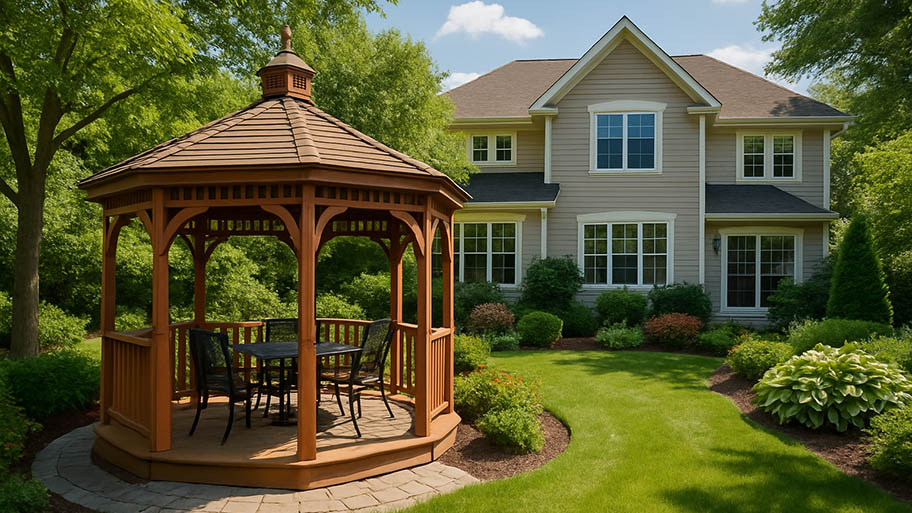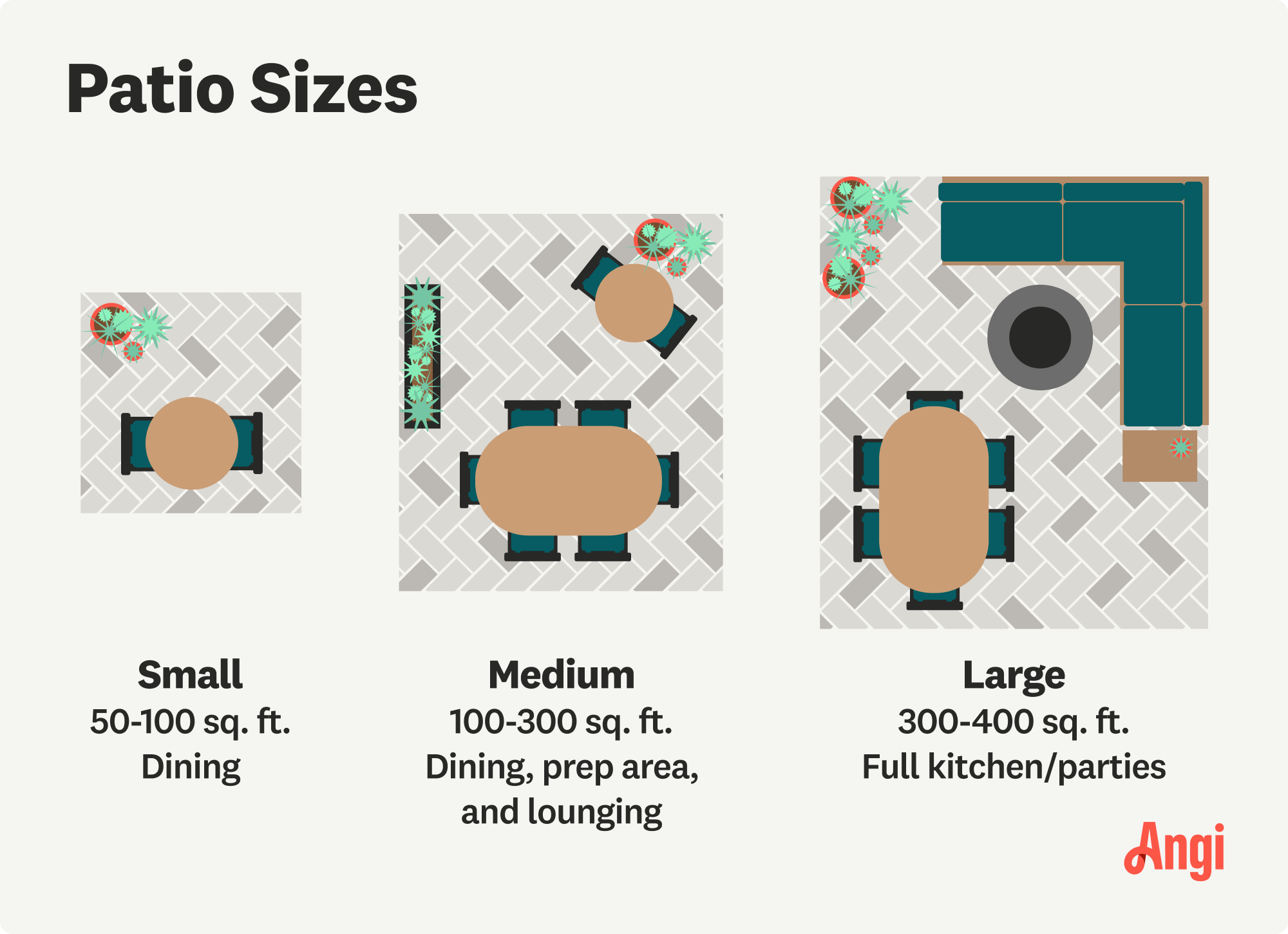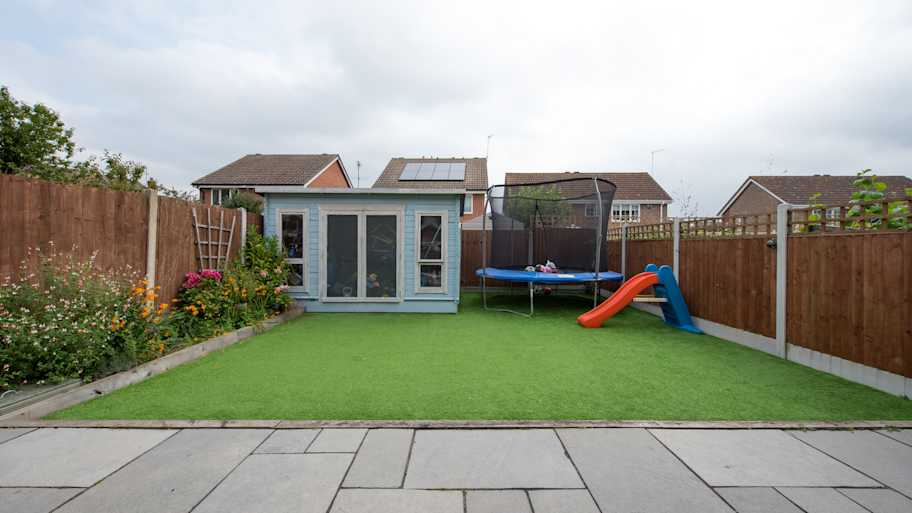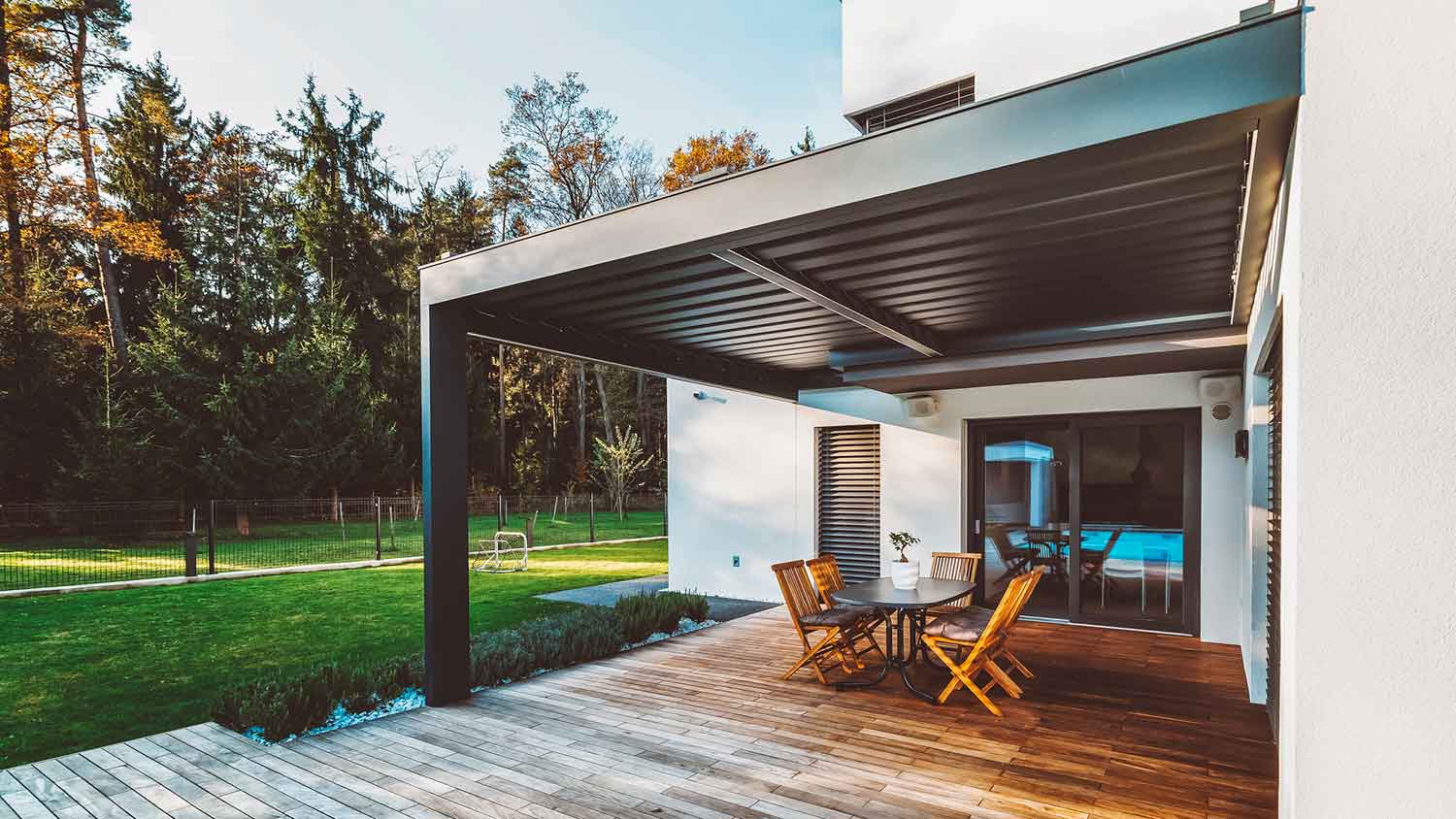
The average gazebo installation cost depends on the size and material. Keep reading to discover how much your gazebo may cost.
Getting the right size for backyard bliss


Patios can range from 50 square feet to over 500 square feet, depending on how you plan on using the space.
Most homeowners opt for patios between 200 and 300 square feet.
A good rule of thumb is not to make your patio any larger than 20% of your home’s square footage.
Consider what percentage of your yard space your patio will take up, as oversized patios can look odd and detract from value in small yards.
Installing a patio in your yard can transform the space into an area perfect for entertaining and enjoying the outdoors in comfort. But first, you’ll have to decide what patio size is right for your home. Undersizing can mean you miss out on utility, while oversizing can mean an awkward appearance, a hit to property value, and less usable yard space. Understanding patio sizes and how to choose dimensions is the first step to making the most of your yard.
Most homeowners install patios between 200 and 300 square feet, with dimensions that vary based on yard size and shape, the plan for using the space, and personal preference. For square patios, 15-by-15 and 18-by-18 feet are the most common, and 12-by-16 and 16-by-18 feet are some of the most common dimensions for rectangular patios.
While these sizes and dimensions are the most prevalent, patio sizes vary widely, depending on many factors, such as home size and yard size.

If you’re not restricted by yard size or budget, a good place to start to choose the right patio size is to think about how you want to use your patio. Small patios in the 50 to 100 square foot range are ideal if you just want a small bistro table for two to four people to have seating, but aim for 400 square feet or more if you want a large area for entertaining and a full-sized outdoor kitchen.
| Patio Square Footage | Patio Size | Ideal For |
|---|---|---|
| 50–100 | Small | Dining for 2–4 |
| 100–200 | Medium | Dining & prep area |
| 200–300 | Medium | Dining & lounging |
| 300–400 | Large | Full kitchen/parties |
Homeowners looking for a small outdoor area where just two to four people can relax on lounge chairs or around a bistro-style dining table should aim for a patio between 50 and 100 square feet. This will take up minimal yard space and keep your budget as low as possible, but you’ll still have a dedicated area for small gatherings.
If you want something a bit more formal, you can upsize to between 100 and 200 square feet. In this case, you can fit a dining area for two to six people, plus an area for food prep, whether a standalone grill or an outdoor island. Alternatively, you could add a small dining table and a small lounge area off to the side for a multi-purpose patio for two to four people.
Larger families and homeowners who want to do some light entertaining should aim for a patio size of between 200 and 300 square feet. This gives you enough room for a dining table that seats four to six, plus a dedicated lounging area for a party of the same size. Depending on the dimensions and the outdoor furniture you buy, you may be able to add a small food prep station or a standalone grill without making the space feel cramped.
A patio between 300 and 400 square feet is large enough to host bigger parties of eight to ten people, or even more. At this size, you can add a full-size outdoor kitchen with bar seating, a dining area, and a lounge area. This is a large patio, though, so it’s only suitable for big yards where it won’t look out of place.

Choosing the right patio size can be a challenge, and it’s best to hire a local patio company to discuss your needs and nail down the right dimensions for your space. Make sure you consider all of the following factors when deciding on an appropriate size for your yard.
How you plan to use your patio should be one of the first things you consider. You can use the patio size table above to figure out the square footage you need to be able to use your patio how you want. You may need to adjust based on other factors, but considering the patio’s purpose first will help maximize your enjoyment of the space.
Next, you should consider the size of your home. A general rule of thumb to follow is to keep your patio size at or under 20% of your home’s square footage. For example, a 200-square-foot patio may be appropriate for a 1,000-square-foot house, but any larger may look out of place. This is to prevent a patio that looks oddly large for the size of your home.
Of course, you can break this rule, but keep in mind that oversized patios may detract a bit from your home value if buyers don’t like the look of a sprawling patio behind a smaller home.
The dimensions of your home can also dictate the dimensions of your patio because it can look odd for a patio to extend far beyond the edges of your house. If your home is deeper than it is wide, your patio should be thinner to match, whereas you can opt for a wider patio with less depth behind a house with a wider footprint.
You should also consider the size of your yard and aim to take up no more than 10% to 20% of your total backyard area with your patio. This is both for aesthetics and for property value concerns, as most buyers will love the utility of a patio but will also want some usable yard space.
A patio differs from a deck in that there normally aren’t setback rules for patios. You can go right up to the edge of your property line with a patio, whereas a deck is a structure that often can’t sit within a few feet of your property line. This gives you a bit more freedom when sizing your patio based on yard dimensions.
The climate in your area can influence your patio size since homeowners in warmer and more moderate climates will have longer periods during which they can enjoy their patios. If you live in an extreme climate, you may not want to budget for a massive patio installation since you may only get to use it a few months of the year. Plus, patios and outdoor areas come with a higher return on investment in warmer climates, so it may be more worthwhile to go bigger with your patio size in a warm climate.
Finally, your budget can affect what size patio is best for you. Patio installation costs between $5 and $50 per square foot, depending on the material you choose. If you want a high-end material like natural stone or a paver patio, you may need to downsize your patio a bit to stay within budget.
If you already have a patio installed but find that it’s not big enough for your liking, you have two options, depending on the type of patio: demolish the existing patio and install a new one or add onto the existing patio.
Consider demolishing the old patio and starting over if the old patio is heavily worn, cracking, crumbling, or in otherwise poor condition. You’ll pay $2 to $6 per square foot to remove the old patio and then $5 to $50 per square foot to install the new one, but you’ll be left with a gorgeous outdoor area that’s perfectly customized to your needs.
If your patio is in good condition and you want to save some money, you can hire a patio pro to pour a new slab adjacent to the old one and refinish the old surface to match, or install new pavers or stones to build onto the existing patio. You may just have some mismatch in the coloration of the pavers until they get weathered.
If you have a concrete patio that’s too large for your liking, the best option is to demolish it and build a new one that’s the right size for your yard and needs. If the existing patio is made of pavers or stones, you can have a pro adjust the size by removing individual pavers and creating a new border, which will save money over a full replacement.
From average costs to expert advice, get all the answers you need to get your job done.

The average gazebo installation cost depends on the size and material. Keep reading to discover how much your gazebo may cost.

A porch can expand your living space and add curb appeal. Find out what to budget for the cost of a porch on your home with this guide.

Flagstone gives your outdoor space a gorgeous, rustic feel. Find out the cost of flagstone per square foot or per ton. Our expert cost guide helps you plan your budget for your flagstone project from walkways to patios to walls.

The primary reason a patio turns green is an abundance of mold, mildew, moss, lichen, or algae. Luckily, there are some ways to avoid this common problem.

Learn how to build stone steps on a slope. Discover the tools, supplies, and instructions needed to create a functional addition to your landscape.

Concrete is ideal for an outdoor patio, walkway, or steps. Here are the questions to ask a contractor about your next concrete installation project.